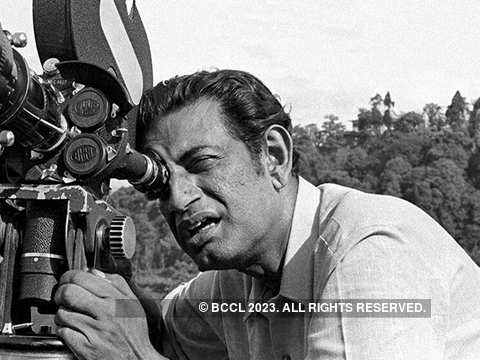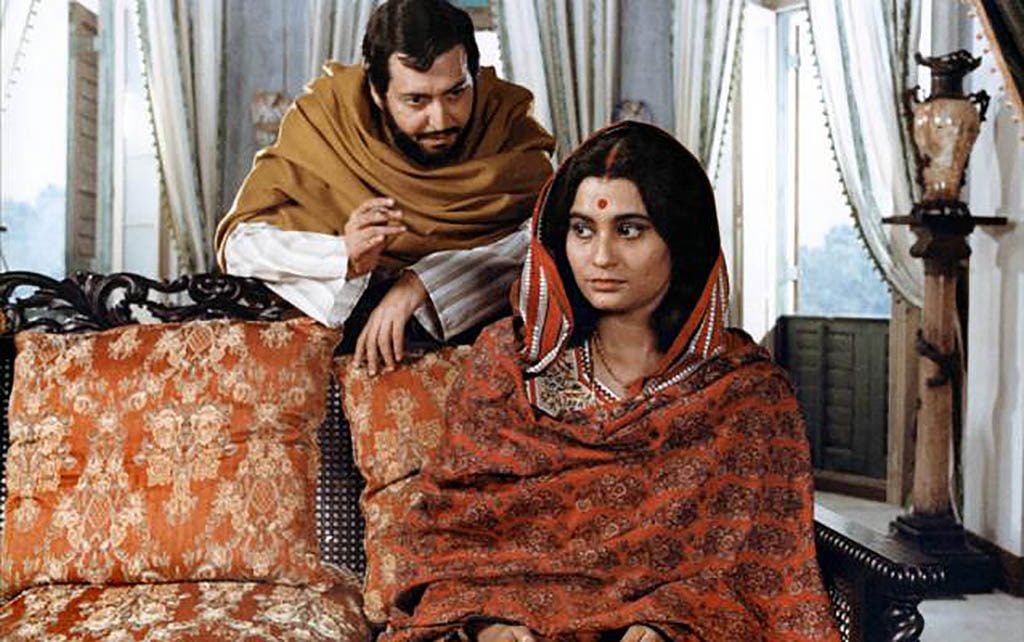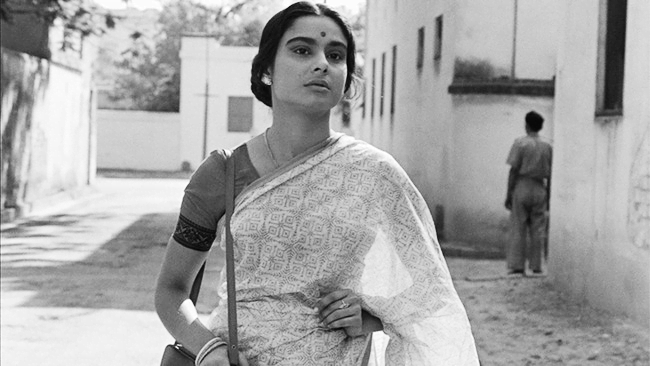Satyajit Ray’s films have always had women characters who occupy a significant part in the film. From Charu and Bimala to Arati and Sutapa, these female characters play pivotal roles in the narrative. Charu (from Charulata, 1964), the lonely, childless bride of a somewhat indifferent newspaper owner, is trapped between tradition and a restless craving for freedom. Bimala’s (from Ghare Baire, The Home And The World, 1984) liberation symbolises the conscious awakening of the Indian woman at the time of the Swadeshi Andolan. Arati, (from Mahanagar, The Big City, 1963) the typical middle-class, seemingly placid housewife, rebels against the barriers of tradition, as she takes on the role of the sole breadwinner of a joint family, if only for a while, whereas Sutapa (from Pratidwandi, 1970) is the image of the modern working woman walking a tightrope along the precarious edges of fragile male egos and social and moral expectations.
This article discusses four of Ray’s immortal women who shatter the stereotypes imposed upon them by an aggressive, male-dominated society.
Charu in Ray’s Charulata: reclaiming love and identity
Charulata is a cinematic adaptation of the poet laureate Rabindranath Tagore’s short story ‘Nashtaneer’ (1901), which in turn is said to have been inspired by the suicide of his beloved sister-in-law, Kadambari Devi, an incident that left an indelible impression on the poet’s mind. Charulata tells us the story of a woman, whose passionate longing for love, freedom and self-identity, traps her in an emotional involvement with her brother-in-law, Amal, a voracious reader and a budding author. She is the epitome of the dutiful, neglected wife whose husband, though not insensitive, is enraptured in his own naïve dreams about western political ideas and social values.
She seeks companionship, a taste of which she gets in Amal, and which for her, begets a sense of attraction. Their common taste of literature paves the ground for a deeper bond, at least on Charu’s part. However, despite the emotional sensitivity, and her sharp contrast with the unimaginative sister-in-law, Manda, Charu too is embroiled in the conflicts surrounding the life of Bengali women in the 19th century—the dynamics between the Prachina (Conservative Woman) and the Nabina (Modern Woman). The moment she takes a bold step out of her mundane world to give vent to her own passions, she is forced to bear the consequences.
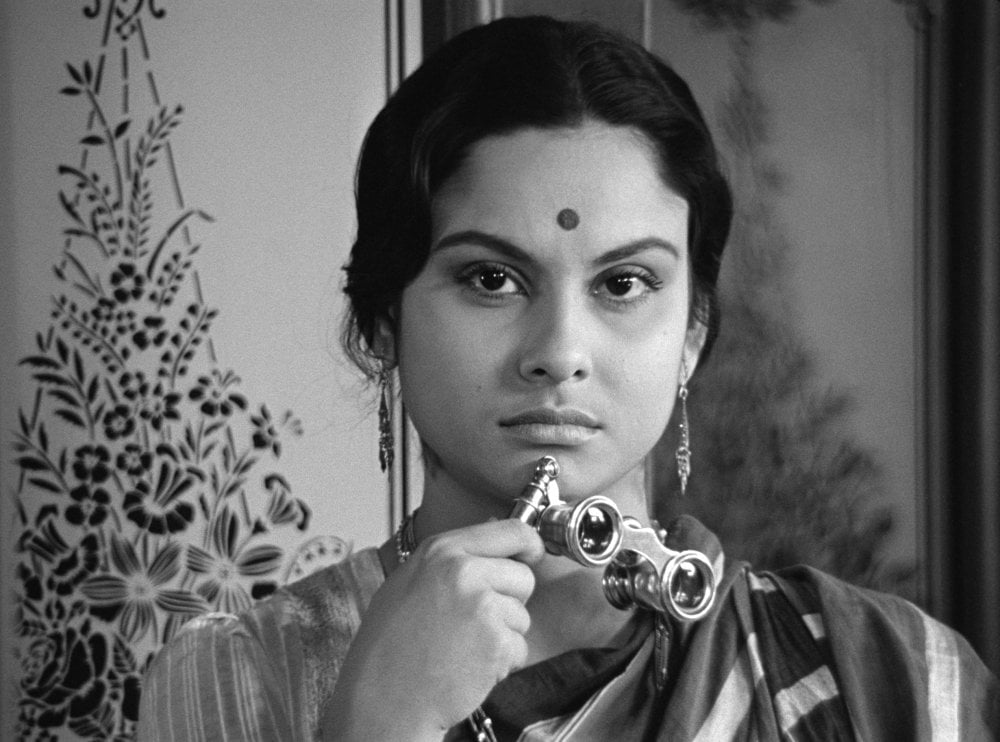
This is expressed through the ambiguous freeze-shot with which the film closes indicates that reconciliation may, but possibly does not, happen. Interestingly, society today is as much averse to even the hint of an extra-marital relationship, particularly where women are concerned, as it was in the 19th century. Thus in Charulata, we find a restless housewife, inadvertently fighting the shackles of society in an effort to reclaim her identity.
Bimala in Ray’s Ghare Baire and the consequences of ‘liberation’
It is this same dialectic between tradition and modernity that traps Bimala in Ghare Baire, an intensely powerful tale of relationships in the backdrop of the Swadeshi Movement after the Bengal Partition of 1905. Nikhilesh, an ardent believer in female emancipation, wishes to liberate his wife from the seclusion women at the time were used to. The memorable scene in the film where Nikhilesh and Bimala walk slowly down the long corridor as doors open before them, is an obvious metaphor symbolising Bimala’s journey from the ‘andarmahal’ to the revolutionary world outside.
Nikhilesh educates his wife and gives her the liberty to interact freely with his friend Sandip. The incipient patriarchy in him ‘allowing’ Bimala her freedom is obscured by the fact that he was enlightened enough to defy the social diktat that married women be confined in their interaction with men who weren’t somehow related to them. One must note that this was a time when Bengali women still used the ghunghat (part of the saree used as a veil) when meeting with strangers. Bimala is swept off her feet by the charming, so-called maverick, who uses foreign lighters for his cigarettes while spouting fiery speeches to promote Swadeshi goods.
Bimala is swept off her feet by the charming, so-called maverick, who uses foreign lighters for his cigarettes while spouting fiery speeches to promote Swadeshi goods.
Yet, to Bimala, he is the ultimate symbol of patriotism. To a woman who has spent most of her early life within the four walls of a room, the sudden passage to an ambience heated by the siren call of ‘Vande Mataram’, of bloodshed and sacrifice, is naturally blinding. Liberated enough to feel the magnetic attraction of a man so different from her staid, passive husband, but not enough to see the latter’s staunch patriotism, Bimala lets herself flow in new-found passion.
When she finally comes to her senses, Nikhilesh forgives her, but pays for her infidelity with his own life, and so does she herself by becoming his widow. Tagore himself allows for the reader’s imagination to run free, as his story ends with Nikhilesh having been gravely injured in an attack. But Ray ends his film with very little ambiguity as Bimala is seen transforming from a married woman’s to a widow’s attire, complete with cropped hair as was the custom for widows at the time.
Charu and Bimala are both Tagore characters, yet they differ from each other substantially. While Charu is gravely in need of marital attention, Bimala has no dearth of it.
Charu and Bimala are both Tagore characters, yet they differ from each other substantially. While Charu is gravely in need of marital attention, Bimala has no dearth of it. Yet, both women are protagonists in what appear to be cautionary tales. Did Bimala and Charu’s moral transgressions make their fates inevitable?
Arati in Ray’s Mahanagar: the gritty modern housewife
From the dark ravages of Bimala’s tragic fate, one can move on to the crowded streets of a relatively modern Kolkata. In Mahanagar, Arati too fights gendered roles and social sanctions. At its simplest, Mahanagar is a story of clashing social values, the gap between an older generation, trying to keep the woman at home, and an younger generation, accepting change for necessity, though the men of this generation still need time for this. Set in the mid-1950s, the film portrays the major societal transformations taking place at the time as more and more middle-class women left the confines of their homes to earn for their families. The traditional joint family was breaking up but this did not prevent the persisting resistance towards women’s employment.
As Arati meekly submits to her husband’s sarcasm, at the same time sticking determinedly to her own resolve, and finally, and impulsively, gives up her job at a moment’s notice, we find behind her placid countenance a woman of grit. The lipstick that she uses only when stepping out of home is an obvious symbol of freedom and modernity. She struggles against her in-laws, disregarding age-old traditions, and gradually becomes the family’s only anchor even as her newly acquired confidence hurts her husband’s ego.
Yet, although Subrata battles his own ego, he ends up serving as a strong and supportive pillar in Arati’s life. One of Ray’s most admirable female characters, Arati is thus not alone in the war she wages with her family, and more generally, society. She and her husband finally find bliss in each other, though both are unemployed and the family’s future weighs down on them.
Sutapa in Ray’s Pratidwandi: to be, or not to be a self-assured woman
Mahanagar leaves the audience with a glimmer of hope as the camera zooms in on a lit street bulb on a bustling Calcutta evening just as the credits roll. But within that same city, perhaps a couple of decades later, Sutapa in Ray’s Pratidwandi emerges a rebel, navigating the same middle-class sensibilities that Arati navigated somewhat tentatively. Sutapa is probably one of Ray’s most contemporary women, ambitious and determined.
Bent on making a life for herself that is unencumbered by social prejudices and prescribed moral arcs, she is certainly more independent than her older brother who very easily equates her material aspirations with dissipation and moral bankruptcy. Yet, Sutapa is unfazed by her family’s social anxieties, or by the growing unrest in 1970s Kolkata that is fast getting embroiled in the Naxalite movement of which her own younger brother is a supporter.
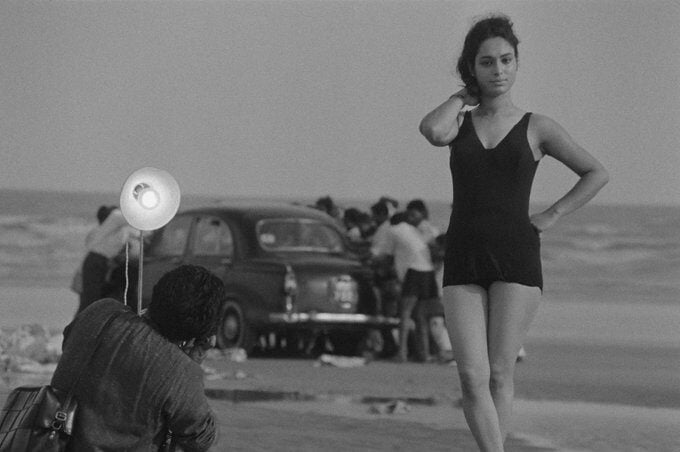
In a world thrust into chaos, Sutapa is slowly but surely getting ready to carve out her own niche, even if that meant revolting against the moral, social and sexual attitude of the society she had grown up in. The fact that Siddhartha, the film’s protagonist, wants his sister to give up the job he feels is physically taxing, morally corrupting, and endangering to the family’s reputation, is indicative of his own fragile ego and insecurities as he is himself unemployed and struggling to find a job.
His dream, read nightmare, where he seems to equate Sutapa’s independence with her sensuality is a window into his own inherent misogyny that associates a woman’s success at work with moral depravity. Sutapa is everything a growingly modern society fears the most–a woman who knows her own mind, and is unafraid of what might and might not be considered socially appropriate.
Sutapa is everything a growingly modern society fears the most–a woman who knows her own mind, and is unafraid of what might and might not be considered socially appropriate.
These Ray women—defined by patriarchy as transgressive—manage to transcend the parameters of a socially constructed and imposed femininity, and take their first unsure step towards liberty. And although their path towards self-discovery is fraught with tension, they still assert, tentatively at first, but less so as times change.

